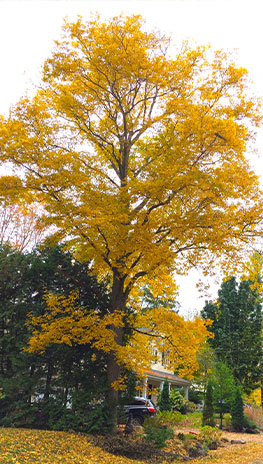SERVICES
“BECAUSE EVERY TREE IS UNIQUE, SO ARE OUR SERVICES”

Changing with the seasons, a tree is a living being that generally grows slowly. Once it has reached maturity, a tree has witnessed many changes around it during its life, often more negative than positive: from the construction of a new building nearby, to the loss of companion trees that have died from the devastating effects of an uncontrollable insect. Nevertheless, a tree has several mechanisms that enable it to defend itself against adversity. Moreover, it has an extraordinary ability to modify its physiological, physiognomic and structural characteristics according to disturbances that occur in its immediate environment. However, in urbanized environments, as trees have become a rarity, as the individuals remaining there are stressed and as “human activity” intensifies, the tree’s response to external events can’t be left to chance; it must be anticipated, evaluated and monitored by a professional.
An arboricultural and urban forestry professional has the ability to recognize tree problems, quantify their scope and degree of risk and correct them by recommending specific actions or treatments.
XYLÈME OFFERS THE FOLLOWING PROFESSIONAL SERVICES:
TREE ASSESSMENT
Private owners, municipalities, institutions, architects, engineers, insurance companies, builders, etc.
TREE-CUTTING PERMIT
Municipal requirements
Detailed report including pictures
Fast service
RESIDENTIAL CONSULTATION
Maintenance tips for trees
Hazard assessment
Alternative to pesticides and lawn advice
URBAN AND SUBURBAN TREE INVENTORY
Characterization and GPS
Priority setting
PRELIMINARY PLANNING AND PROFESSIONAL SUPPORT
Construction, planting and miscellaneous development
MANAGEMENT OF TREE PARKS
Inventory
Maintenance plan
Replacement plan
DISEASE AND INSECT DETECTION
PLANTING AND REPLACEMENT PLAN
Selection of suitable species
Marking of sites
IMPACT STUDY
Construction work, Preservation and mitigation measures
PLANT PEDOLOGY (SOIL) ASSESSMENTS
Physico-chemical characterizations, amendment requirements / Fertilizers and management plans
ENVIRONMENTAL GEOMATICS
Creation and updating of data models with spatial integration of the diversified plant heritage
FINANCIAL EVALUATION
Damaged tree
Without litigation
Did you know that…




